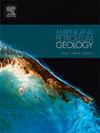甲烷在纳米多孔页岩中的量子物理吸附行为:模型和新机制
IF 3.7
2区 地球科学
Q1 GEOSCIENCES, MULTIDISCIPLINARY
引用次数: 0
摘要
甲烷在纳米多孔页岩中的吸附对页岩气的储存和流动起着重要作用。尽管之前已经提出了许多理论模型来描述气体吸附行为,但纳米孔隙中的势能分布如何影响气体吸附仍不清楚。甲烷在极其复杂的纳米孔隙中的吸附机理仍未得到令人满意的解释。本研究利用位于古生代-中生代不同沉积环境地层中的 28 个页岩样本,研究了甲烷在纳米孔页岩中的量子物理吸附性质和过程。研究结果表明,甲烷在纳米级空间内具有量子效应,甲烷的物理吸附行为可能是分子能级转换的结果。此外,通过考虑量子势能分布、最大吸附量、气体温度和气体压力,建立了量子物理吸附模型,该模型能很好地匹配各种页岩在温度和气体压力变化较大条件下的等温吸附数据。该模型还可以得到不同能级的甲烷吸附量。最后,提出了甲烷在纳米多孔页岩中量子物理吸附的新机制。气体分子的不均匀空间分布和气体吸附的基本空间是控制量子物理吸附行为的内在因素。前者主要受最小电位单位(E0)和气体温度的影响,后者以最大吸附量参数(nL)为代表,受比表面积和气体温度的影响。气体压力只影响不同能级的分子浓度,但不影响分子的空间分布。在不同沉积环境的页岩中,E0 和 nL 会因有机物性质(TOC 含量和角质类型)的不同而不同,这间接影响了甲烷的物理吸附行为。这些结果有助于深入了解甲烷在页岩中的存储情况,提高页岩气的开发效率。此外,这项研究有望为纳米多孔介质中气体的量子物理吸附开辟一个新的研究方向。本文章由计算机程序翻译,如有差异,请以英文原文为准。
Quantum physisorption behavior of methane in nanoporous shales: Model and new mechanism
Methane adsorption in nanoporous shales plays a significant role in the storage and flow of shale gas. Although previously numerous theoretical models have been proposed to describe the gas adsorption behavior, how the potential energy distribution in nanopores impacts gas adsorption remains unclear. The mechanism of methane adsorption in extremely complicated nanopores is still no satisfactory explanation. In this study, a total of 28 shale samples located in the Paleozoic-Mesozoic strata from different sedimentary environments were utilized to investigate the nature and process of quantum physisorption of methane in nanoporous shales. It was suggested that methane confined within nanoscale space shows a quantum effect, and the physisorption behavior of methane may be the result of molecular energy level transition. Further, the quantum physisorption model was developed by considering the quantum potential energy distribution, maximum adsorption amount, gas temperature and gas pressure, which matches the isothermal adsorption data well for a various of shales under widely varied temperature and gas pressure condition. The adsorption amounts of methane with different energy levels can also be obtained by the model. Finally, a new mechanism of the methane quantum physisorption in nanoporous shales was proposed. Uneven spatial distribution of gas molecules and elementary space of gas adsorption are the intrinsic factors of controlling the quantum physisorption behavior. The former is mainly influenced by minimum potential unit (E0) and gas temperature, while the latter is represented by the parameter of maximum adsorption amount (nL) which impacted by specific surface area and gas temperature. Gas pressure only affects the molecule concentration with different energy levels, but does not affect the spatial distribution of molecule. E0 and nL vary in shales from different sedimentary environments, due to the difference in organic matter properties (TOC content and kerogen type), which indirectly impacts the methane physisorption behavior. These results are helpful to deeply understand the storage of methane in shales and improve the efficient development of shale gas. In addition, this study is expected to open a new research direction about the quantum physisorption of gas in nanoporous media.
求助全文
通过发布文献求助,成功后即可免费获取论文全文。
去求助
来源期刊

Marine and Petroleum Geology
地学-地球科学综合
CiteScore
8.80
自引率
14.30%
发文量
475
审稿时长
63 days
期刊介绍:
Marine and Petroleum Geology is the pre-eminent international forum for the exchange of multidisciplinary concepts, interpretations and techniques for all concerned with marine and petroleum geology in industry, government and academia. Rapid bimonthly publication allows early communications of papers or short communications to the geoscience community.
Marine and Petroleum Geology is essential reading for geologists, geophysicists and explorationists in industry, government and academia working in the following areas: marine geology; basin analysis and evaluation; organic geochemistry; reserve/resource estimation; seismic stratigraphy; thermal models of basic evolution; sedimentary geology; continental margins; geophysical interpretation; structural geology/tectonics; formation evaluation techniques; well logging.
 求助内容:
求助内容: 应助结果提醒方式:
应助结果提醒方式:


